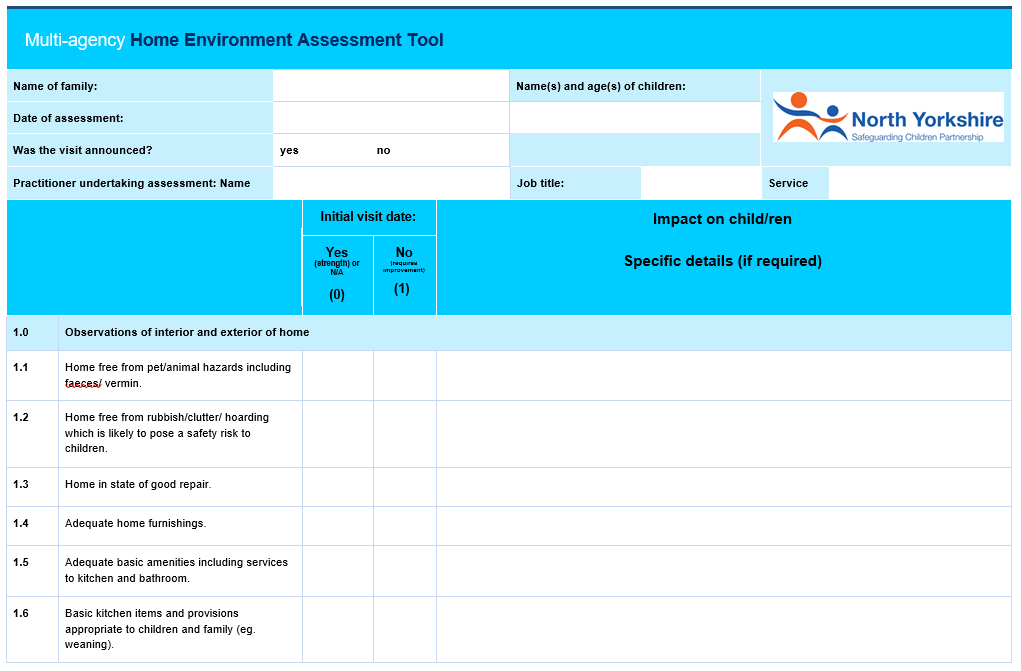Home Environment Assessment Tool (HEAT)
INTRODUCTION:
The assessment tool has been developed with practitioners. It is designed to help practitioners identify those families where there may be early signs of neglect so that prompt action can be taken to address and support families to improve home conditions and safety for their children.
The HEAT should not be used in isolation and should form part of the overall assessment that is being undertaken.
The tool recognises that practitioners must make judgements about the safety, order and cleanliness of the homes in which children live. The tool has been designed to help practitioners to be objective about their observations and evidence their concerns.
If an unborn child or infant is in the family an assessment of the infants sleeping environment should also be completed. See NYSCP’s Day or Night, Sleep Right Multi-Agency Risk Minimisation Guidance and resources
WHEN TO USE THE ASSESSMENT TOOL:
Professionals should follow their own service specific guidance as to the requirements of when to complete the assessment tool with families.
The HEAT assessment tool should be used as part of a wider assessment of a family’s needs to provide insight of the home environment.
The HEAT assessment can be used as a prompt to support a service’s specific assessment rather than completing this assessment in addition.
USING THE ASSESSMENT TOOL:
Consent:
The assessment tool should be completed jointly with families; this creates greater openness and a common understanding of the areas that may cause concern. Consent should be gained as part of this process. The questions in the assessment tool have been worded in a positive way to minimise the risk of families feeling anxious about the assessment. The delivery of the assessment families should also provide some reassurance that a supportive approach is being adopted.
If consent is not gained, then practitioners need to document this, analyse risk and consider seeking further safeguarding advice.
It is important when carrying out the assessment, that the practitioner has a clear picture of the home environment from the child’s point of view.
Where there is more than one child within the family, the HEAT should be completed from each child’s perspective e.g. a young baby who is at crawling stage will be more affected by dirt on the floor however an older child may be more affected by dental decay.
SCORING:
Answers to the HEAT: Answer Yes if there are no issues and No if issues are evident.
Depending on the age of the children, different items may give more or less concern, but in general the higher amount of ‘No’ responses, the greater the concern.
Items should be scored on the basis of what is observed.
A single item may be enough to raise a significant concern as well as a number of items together.
Specific details should be recorded by the practitioner of what is actually seen to help develop specific actions to address improvements required.
WHAT TO DO IF THE HEAT RAISES CONCERNS:
Whilst for many families the completion of the assessment tool will raise no concerns, for those that do, the practitioner should use the assessment tool to help gain an understanding of why difficulties are evident so that appropriate and supportive actions can be identified that will help the family to make the required improvements.
Unless an issue raises a concern that a child or a young person may be at risk of immediate or significant harm, practitioners should take appropriate supportive action to address the issues of concern with families. Actions that are agreed with the family, together with direct help and support should be provided to the family and a review should be carried out within a reasonable timescale.
Actions should be agreed with the family and recorded in the actions section of the HEAT.
If the concerns raised require additional support, a practitioner should follow North Yorkshire’s Early Help process. Within this process it may be appropriate for a practitioner to complete an Early Help Assessment with the family, with a view to holding a Team Around the
Family depending on the conclusions drawn from the Early Help Assessment. For more information on the Early Help process in North Yorkshire see the Early Help One Minute Guide.
If concerns raised place the child in immediate danger, a practitioner should contact the police on 999. If a practitioner believes the concerns raised place the child at significant risk and harm a telephone contact to North Yorkshire Multi-Agency Screening Team (MAST) can be made on 0300 131 2 131.
A written referral to MAST can be made via the Universal Referral Form and must be completed and submitted within 24 hours of a practitioner’s telephone contact. For more information on the safeguarding referral process in North Yorkshire, visit the Worried About a Child page on the NYSCP website.





 View all our news
View all our news